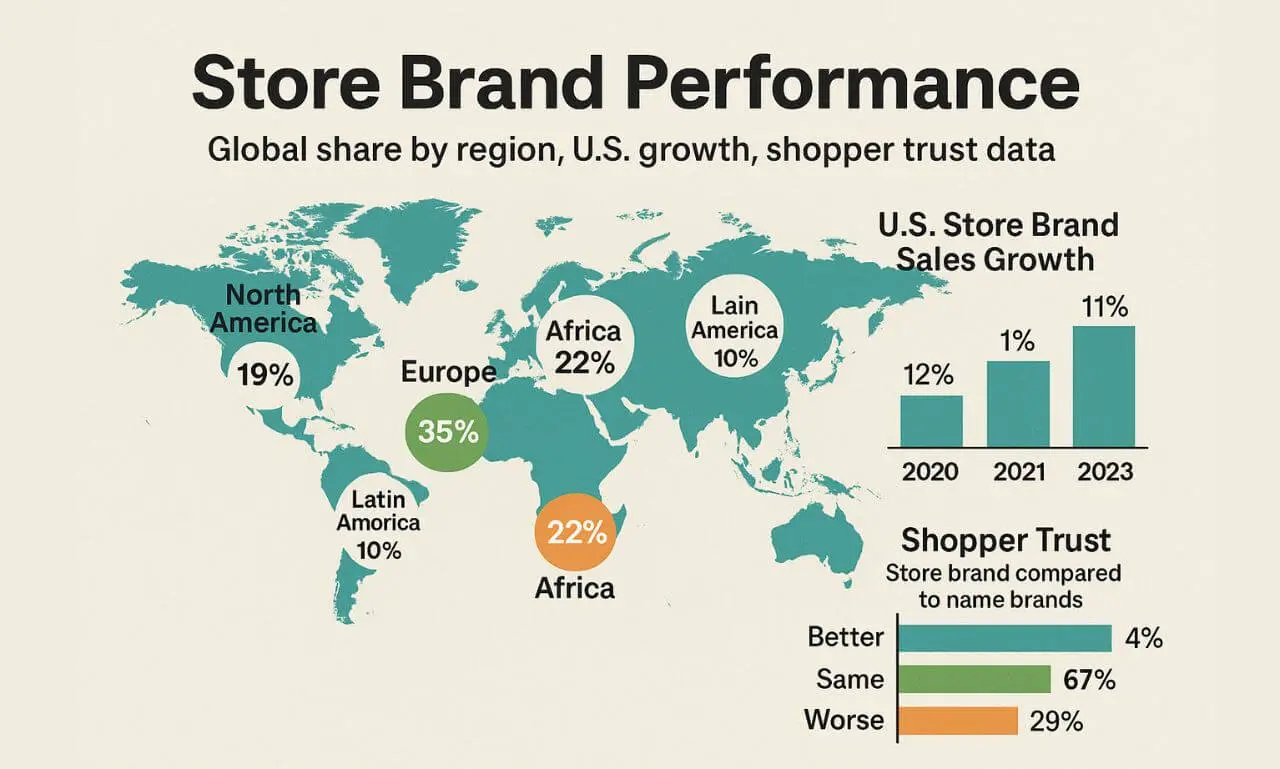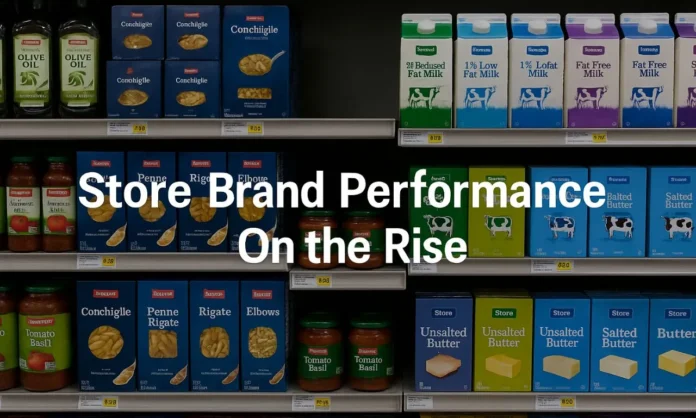The Store Brand Performance has now become a primary source of the supermarket strong performance. There is an increase in sales of the private labels in all major regions. Retail chains are developing own brands in the value; organic and premium lines. There has been a challenge to national brands.
Pricing difference is large and the difference in the quality is narrowing at a rapid rate. The report is based on validated data to analyse the way store brand performance is transforming across the regions. It compares rates of growth, category share and consumer response. It also observes the comparison of the performance against national brands.
Store Brand Performance In Global Markets
By 2024 store brands increased at a rate that many credit analysts did not anticipate. There was increased dollar sales at the level of private label across all major food and household groups. Dairy, pantry staples, beverages and home care registered the largest gains. In United States and Europe, growth was strong and now Africa and Asia have gained further momentum to be stronger. The number of sales of private labels in the U.S. was at its peak.
It was the first time when dollar share exceeded 20 percent. Unit share crossed the 23 per cent. This summed the sales of store brands in groceries that amounted to 271 billion dollars compared to 262 billion a year before. It is the fourth straight built of the private label expansion in the American market.
The store brand performance was also stable across the world. Value of the private label increased both in established and in emerging economies. Although the top ten national brands achieved gains, store brands made a gain on most of the grocery categories.
Global Store Brand Performance – 2024 Snapshot
| Region | Dollar Share | Growth Trend | Notes |
|---|---|---|---|
| United States | 20.7% | Record high | Driven by value demand and innovation |
| Europe | 35–45% (avg) | Slower but stable | Strong in dry grocery and chilled |
| Latin America | 10–15% | Accelerating | Entry-level brands expanding |
| Asia-Pacific | <10% (varies) | Gaining share | Growth in modern retail formats |
Store Brand Performance remains highest in Europe, but the U.S. has the most active recent gains in both value and volume. In Asia and Latin America, performance is improving as retailers expand private label across new formats.
Consumer Perception and Quality Trends
There is also the improvement of Store Brand Performance wherein the shoppers trust them more. The distance between national and the personal brands is becoming narrow. A majority of consumers have come to consider the store brands as value. To many, they are equally as good. Retailers in various markets are currently selling three or more levels of private labels even organic, premium, and specialty brands. T
hese trends are motivated by younger shoppers. Basic or low cost items are no longer the only store brand. They now have gourmet, regional products and health-oriented ones. A lot of customers also go to private label in terms of purchasing staple products since it results in foreseeable pricing and in-stock performance.
Success of Private labels is also associated with improvements in packaging. Store brands are distinguished by clear labelling, simplified design and modern branding. This will enhance shelf presence and increase the rate of repeat purchase.

Store Brand Performance does not spring up equally anywhere. In Europe, the number of years in which the share of private labels has been high has been through Germany, Netherlands, Spain and U.K. Growth in the European market has been modest as the European market has become more mature. Retailers, however, keep introducing new lines and gain margins. Store brand is gaining market in the U.S. fast.
The performance of the privately labelled brands is reported to be very strong in grocery, frozen, and home care by most major supermarket chains. There is also a high performance in the areas of mass retailing and discounting. Asia-Pacific markets have low company share in the form of store brands yet large potential. Contemporary retail chain stores are augmenting the shelf space allocation to the commodities of the house brands.
Such as noodles, rice, sauces and beverages, new categories are being entered by new branded products. Most of them have regional processors and co-manufacturers in their support. The growth in Latin America is at an early stage. In household and dry goods, the retailers are introducing entry-level personal labels. The products will carter to growth of store traffic and maintenance of value-minded customers.
Store Brands vs National Brands
Stores Brand Performance now follows the performance of major manufacturer very closely. The fastest-growing segment occurs in most categories, store brands are the fastest growing. Although the best world brands continue to dominate in advertisement and innovation, the prize of low cost, consistency and retail power goes to the one with classy trade mark which is the private label. T
he gap between the average price between the store brands and national brands is a huge one. The generic products are selling in excess of 25 percent less on a per unit basis of the product in certain markets. This is a price benefit that conserves volume when inflation occurs and there is a decrease of consumers. Retailer also employs the avenue of private label to control margin. Under its ownership, supermarkets will be able to save costs by sourcing, maintain shelf presence.
This heightens bargaining power with the suppliers and enhances stock movement. Loyalty is also valid because of the growth of private label. When successfully performed, store brands will make shoppers come back. This is carried out across e-Commerce and in-store channels and aids in the integration of multichannel retailing.
Category-Specific Performance Highlights
There is high diversity in Store Brand Performance by product categories. The successfulness varies with the priorities on the part of the consumer, the complexity of a supply chain, and retailer strategy. In the dairy sector, there is usually a shelf share of more than 30 percent in the private label.
Organic and lactose free levels have become ingredients in store labels of many retailers. Value store yogurts and cheese registers the highest growth rate as consumers demand substitutes to the premium brands in the nation. Retailers usually have greater margins on their own-label in home care and in home cleaning products.
The latter types do not need product innovation. The packaging and quality are simple and thus suitable to price-sensitive products. Repeat purchases make performance strong. The frozen and chilled food industries were the next to experience the rapid expansion of the private label.
Emergence of new way of thinking such as premium frozen pizzas, ready meals and veggie snacking mixes contribute to the sale. It also maintains steam with seasonal promotions and bundled offers in both the stores and on the web.
Old favourites such as dry packaged items (rice, pasta, canned vegetables) continue to be among the major store brand share drivers especially in the European and Latin American markets. These products are kept high-profiled through heavy promotional calendars and a reliable price gap that keep them dominant in the assortments of supermarkets.
Retailer Sourcing and Supply Models
Store Brand Performance depends heavily on retailer control over sourcing and supply. Three key strategies are now in widespread use:
1. Co-manufacturing partnerships: Retailers contract regional producers under own-brand specifications. This model lowers costs and improves flexibility. It is common in dairy, cereals, and personal care.
2. Global procurement networks: Large chains and discounters source raw inputs in bulk, then distribute manufacturing. They negotiate terms directly with suppliers for consistent quality and cost control.
3. Private-label incubators: Major retailers create in-house product teams to develop and test private label lines. They fund product development, packaging design, and consumer feedback cycles—reducing time-to-market compared to partners.
These models contrast with national brands, which rely on dedicated, brand-aligned manufacturing and marketing networks. Store Brand Performance gains come from efficient, low-margin, retail-optimized sourcing.
Risk and Compliance Considerations
Despite growth, store brand programs carry risks. Quality consistency, regulatory compliance, and supply disruption pose ongoing challenges for retailers.
In food safety, private label products must meet the same standards as national brands. Mistakes in allergen declarations, inspections, or traceability can harm store brand trust in a single incident.
Regulatory risk varies. For example, organic certification involves tight controls. Meat, seafood, and fresh produce carry country-of-origin and pesticide residue requirements. Private label errors can expose retailers to fines and reputation damage.
Supply chain shocks—such as sudden raw material cost spikes, port delays, or factory closures—can directly impact store brands. Without buffer agreement terms, retailers may face lost sales or consumer backlash. Store Brand Performance success requires agile supply monitoring and risk-buffer mechanisms.
Year-Ahead Outlook and Buyer Takeaways
Looking ahead, Store Brand Performance is expected to remain strong across most grocery and household categories in 2025. Retailers should expect:
- Price-conscious consumers to continue driving store brand volumes
- Premium tiers (organic, gourmet) to expand as middle-income shoppers seek quality
- Digital sales of store brands to accelerate via subscriptions and online baskets
- Sustainability trends furthering value for branded products with ethical or eco credentials
- Cross-category bundles (e.g., pantry box bundles) gaining traction under private label labels
Buyers and procurement leads should take note:
- Track performance by category to identify high-potential tiers
- Prioritize supplier partnerships with risk buffers and quality guarantees
- Develop price-tiered lines (value, standard, premium) to meet evolving demand
- Use shopper data to guide packaging, SKU strategy and digital bundling
- Monitor regulatory changes to ensure private label labels meet local standards
Final Takeaway
Store Brand Performance now serves as a benchmark for both retailer health and consumer value perception. In emerging markets, store brands are gaining ground. In mature markets, they drive innovation within established categories. To succeed in 2025 and beyond, supermarket leaders must treat private label as a strategic asset—not just a price tool.



